Multiresolution Modeling of a Modular Building Design Process Based on Design Structure Matrix
Abstract
:1. Introduction
2. Literature Review
2.1. Research on Manufacturing Product R&D Process
2.2. Research on Architectural Design Process
2.3. Research on Multiresolution Modeling
- The resolution of a complex product model: The level of detail and detail that the model describes the hierarchy, stages, static attributes, and dynamic behavior of the object. Generally speaking, models with higher levels, earlier design stages, fewer details, and lower levels of detail are called low-resolution models; a model with a lower level, a later design stage, more detail, and a higher level of detail is called a high-resolution model.
- Model aggregation: The process of converting a higher resolution model into a lower resolution model.
- Model disaggregation: The process of converting a lower resolution model into a higher resolution model.
3. Multiresolution Modeling Based on DSM
3.1. Product Design Process Optimization Based on DSM
3.2. Multiresolution Modeling
4. Case Study
4.1. Design of Aluminum Alloy Modular Building
4.2. Multiresolution Modeling of Modular Building Design Process Based on DSM
5. Model Simulation and Result Analysis
5.1. Example Data of Aluminum Alloy Modular Buildings
5.2. Simulation Results and Analysis
5.2.1. Comparative Analysis of Schedule and Cost for Models with Different Resolutions
5.2.2. Evaluation of Differences in Models with Different Resolutions
- (1)
- Schedule variance assessment
- (2)
- Cost variance assessment
6. Discussion and Conclusions
- (1)
- The multiresolution modeling method based on the DSM is universal for the research of complex systems, and is also applicable to the risk analysis of the design process of modular building, which can effectively improve the accuracy of system analysis.
- (2)
- For the average schedule of the design process, the results of high-resolution models are significantly lower than those of low-resolution models, and the optimization of high-resolution models further reduces them. The reason comes from identifying parallel tasks, reducing coupling, and avoiding cross stage rework, thereby shortening the R&D and construction cycles.
- (3)
- By comparing the average cumulative time spent on R&D activities of models with different resolutions horizontally, it was found that due to the high level of detail and complexity in stages 3, 4, and 5 of modular buildings, they should be modeled and analyzed at higher resolutions to ensure high reliability of the results. For stages 1, 2, and 6, low resolution modeling is sufficient.
- (4)
- Considering the high workload and difficulty of modeling high-resolution models, approximate estimation methods can be used on the basis of low-resolution models to alleviate the dependence on high-resolution models and modeling costs to a certain extent.
Author Contributions
Funding
Data Availability Statement
Conflicts of Interest
Appendix A
| Serial Number | Technical Term | Abbreviation | Explain |
|---|---|---|---|
| 1 | design structure matrix | DSM | See Section 3.1 for details |
| 2 | research and development | R&D | / |
| 3 | low-resolution model | / | See Section 2.3 for details |
| 4 | high-resolution model | / | See Section 2.3 for details |
| 5 | multiresolution model | / | including low resolution model and high-resolution model |
References
- Zeng, S.F. Research on Optimization of New Product R&D Process of M Company. Master’s Thesis, Overseas Chinese University, Taichung City, Taiwan, 2022. [Google Scholar] [CrossRef]
- Wang, J. Research on the Optimization of the R&D Process for New Medical Device Products of ZK Company. Master’s Thesis, University of Electronic Science and Technology, Chengdu, China, 2022. [Google Scholar] [CrossRef]
- Xu, T.; Qiao, L.H.; Zhao, H.Q. A Flexible Modeling Method for Product R&D and Design Workflow Based on Petri Nets. Mod. Manuf. Eng. 2021, 484, 58–63. [Google Scholar] [CrossRef]
- Feng, L.Q.; Huang, D.L.; He, Z.; Li, W.C. Process Modularization Analysis Method for Complex Product R&D Projects. Ind. Eng. 2018, 21, 10. [Google Scholar]
- Yu, T.; Yin, H. Analysis of Product Innovation Mechanism and Process of Financial Institutions. Dongyue Analects 2015, 36, 92–96. [Google Scholar] [CrossRef]
- Gu, D.Z. Research on Product Development Process Optimization of YF Company Based on Design Structure Matrix. Master’s Thesis, Donghua University, Shanghai, China, 2020. [Google Scholar] [CrossRef]
- Zeng, J.Z. Research on Product R&D Process Optimization of S. Company. Master’s Thesis, South China University of Technology, Guangzhou, China, 2018. Available online: https://kns.cnki.net/KCMS/detail/detail.aspx?dbname=CMFD201802&filename=1018874769.nh (accessed on 17 August 2023).
- Yang, G.H.; Liu, J.H. Modeling and Optimization of Complex Product Development Processes Based on DSM and SysML. J. Comput. Aided Des. Graph. 2017, 29, 921–928. [Google Scholar]
- de Carvalho, R.A.; da Hora, H.; Fernandes, R. A process for designing innovative mechatronic products. Int. J. Prod. Econ. 2020, 231, 107887. [Google Scholar] [CrossRef]
- Liu, C. Process Product Design Based on Multimode Interaction Design; Hindawi Limited: London, UK, 2021. [Google Scholar] [CrossRef]
- Sheng, H.T.; Wei, F.J. The Research and Application of Genetic-Based Design Structure Matrix Optimization Algorithm. Chin. J. Manag. Sci. 2007, 15, 98–104. [Google Scholar] [CrossRef]
- Sinha, K.; Han, S.Y.; Suh, E.S. Design structure matrix-based modularization approach for complex systems with multiple design constraints. Syst. Eng. 2019, 23, 211–220. [Google Scholar] [CrossRef]
- Gunawan, G.; Yanuar, Y.; Waskita, F.A.; Kurniawan, A. Modularization of Ship Engine Room Using Design Structure Matrix (DSM) Based on the Genetic Algorithm. Eng. J. 2020, 24, 205–216. [Google Scholar] [CrossRef]
- Browning, T. Systems Architecting and Program Management with the Design Structure Matrix (DSM). INCOSE Int. Symp. 2013, 23, 1632. [Google Scholar] [CrossRef]
- Deng, L.N.; Zhou, Z.; Ye, X.; Liao, L.; Lei, L.Z. Deepening the Design Process of Assembled Components Based on BIM. J. Guilin Univ. Technol. 2021, 41, 797–803. [Google Scholar]
- Wang, Q.W.; Zhang, J.W.; Niu, Z.B. Process Analysis of Building Multidisciplinary Collaborative Design Based on BIM. J. Tongji Univ. (Nat. Sci. Ed.) 2018, 46, 1155–1160. [Google Scholar]
- Letizia, D.A.; Magdalena, H.; Federico, S.; Marcus, M.K. A novel BIM-based process workflow for building retrofit. J. Build. Eng. 2022, 50, 104163. [Google Scholar]
- Sigalov, K.; König, M. Recognition of process patterns for BIM-based construction schedules. Adv. Eng. Inform. 2017, 33, 456–472. [Google Scholar] [CrossRef]
- Lee, J.H.; Jun, H.J. A Study on the Adaptability of BIM-based Integrated Building Design Process in Domestic Architectural Design Firms. Korean Inst. Inter. Design. 2007, 16, 19–27. [Google Scholar]
- Cong, M. From Construction to Design. Construction, Performance, Humanities and Design Series. Ph.D. Thesis, Nanjing Southeast University, Nanjing, China, 2017; p. 206. [Google Scholar]
- Yassine, A.; Braha, D. Complex concurrent engineering and the design structure matrix method. Concurr. Eng. 2003, 11, 165–176. [Google Scholar] [CrossRef]
- Chen, W.; Sun, X.; Chen, R.; Li, H. Optimization of Control and Design of Prefabricated Components of Fabricated Buildings Based on QFD-DSM. J. Civ. Eng. Manag. 2020, 37, 39–45. [Google Scholar]
- Browning, T.R. Applying the design structure matrix to system decomposition and integration problems: A review and new directions. IEEE Eng. Manag. 2001, 48, 292–306. [Google Scholar] [CrossRef]
- Yassine, A. Introduction to Modeling and Analyzing Complex Product Development Processes Using the Design Structure Matrix (DSM) Method. Urbana 2004, 51, 1–17. [Google Scholar]
- Li, Z.K. Research on Collaborative Architectural Design Based on DSM. Master’s Thesis, Tianjin University, Tianjin, China, 2018. [Google Scholar] [CrossRef]
- Gunawan, I.; Ahsan, K. Project scheduling improvement using design structure matrix. Int. J. Proj. Organ. Manag. 2010, 2, 311–327. [Google Scholar] [CrossRef]
- Pekta, S.S.T.; Pultar, M. Modelling detailed information flows in building design with the parameter-based design structure matrix. Des. Stud. 2006, 27, 99–122. [Google Scholar] [CrossRef]
- Zhao, L.; Wang, Z. Process Optimization Calculation Model and Empirical Research of Prefabricated Buildings Based on DSM. In ICCREM 2019; American Society of Civil Engineers: Reston, VA, USA, 2019; pp. 614–621. [Google Scholar]
- Hyun, H.; Kim, H.; Lee, H.S.; Park, M.; Lee, J. Integrated Design Process for Modular Construction Projects to Reduce Rework. Sustainability 2020, 12, 530. [Google Scholar] [CrossRef]
- Ma, G.; Hao, K.; Xiao, Y.; Zhu, T. Critical chain design structure matrix method for construction project scheduling under rework scenarios. Math. Probl. Eng. 2019, 2019, 1595628. [Google Scholar] [CrossRef]
- Le, Y.; Sun, Q.; Chen, J.G.; Tang, K.W. Preliminary Progress Optimization of Large and Complex Airport Projects Based on Design Structure Matrix. J. Tongji Univ. (Nat. Sci. Ed.) 2020, 48, 1523–1529. [Google Scholar]
- Oloufa, A.A.; Hosni, Y.A.; Fayez, M.; Axelsson, P. Using DSM for modeling information flow in construction design projects. Civ. Eng. Environ. Syst. 2004, 21, 105–125. [Google Scholar] [CrossRef]
- Brady, T.K. Utilization of Dependency Structure Matrix Analysis to Assess Complex Project Designs. In Proceedings of the ASME 2002 International Design Engineering Technical Conferences and Computers and Information in Engineering Conference, Montreal, QC, Canada, 29 September–2 October 2002. [Google Scholar] [CrossRef]
- Bulloch, B.; Sullivan, J. Application of the Design Structure Matrix (DSM) to the Real Estate Development Process; Massachusetts Institute of Technology: Cambridge, MA, USA, 2009. [Google Scholar]
- Yang, J.R.; Lin, Q.Q.; Liu, W.Z.; Zhang, W.J.; Zhang, M.H. Multi resolution model aggregation and disaggregation framework for complex products. In Proceedings of the 33rd China Simulation Conference, Kunming, China, 22–24 May 2021; pp. 103–108. [Google Scholar] [CrossRef]
- Yue, M.Q.; Qi, J.X. Multi resolution modeling methods for marine weapons and equipment. Ship Electron. Eng. 2022, 42, 31–34, 53. [Google Scholar]
- Xu, Y.F.; Lv, J.W.; Xie, Z.R.; Wang, G.Q. A Multiresolution Risk Assessment Method for Complex Systems Considering Technical Risks. J. Natl. Def. Univ. Sci. Technol. 2018, 40, 161–170. [Google Scholar]
- Xu, Y.F.; Lv, J.W.; Yang, J.; Wang, G.Q. Multi resolution modeling of ship design process based on design structure matrix. J. Harbin Eng. Univ. 2019, 40, 102–111. [Google Scholar]
- Steward, D.V. The design structure system: A method for managing the design of complex systems. IEEE Eng. Manag. 1981, 28, 71–74. [Google Scholar] [CrossRef]
- Maheswari, J.U.; Varghese, K.; Sridharan, T. Application of Dependency Structure Matrix for Activity Sequencing in Concurrent Engineering Projects. J. Constr. Eng. Manag. 2006, 132, 482–490. [Google Scholar] [CrossRef]

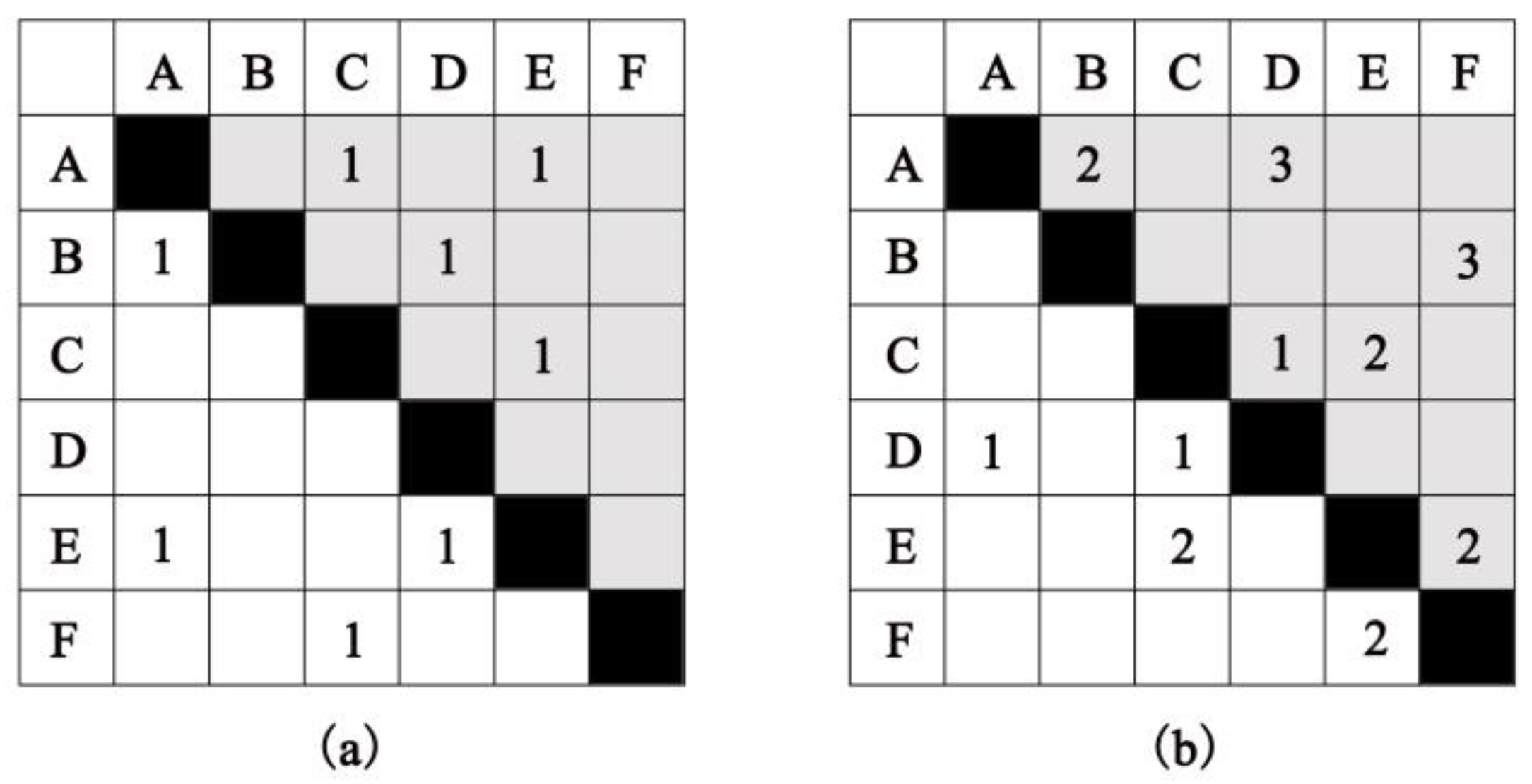



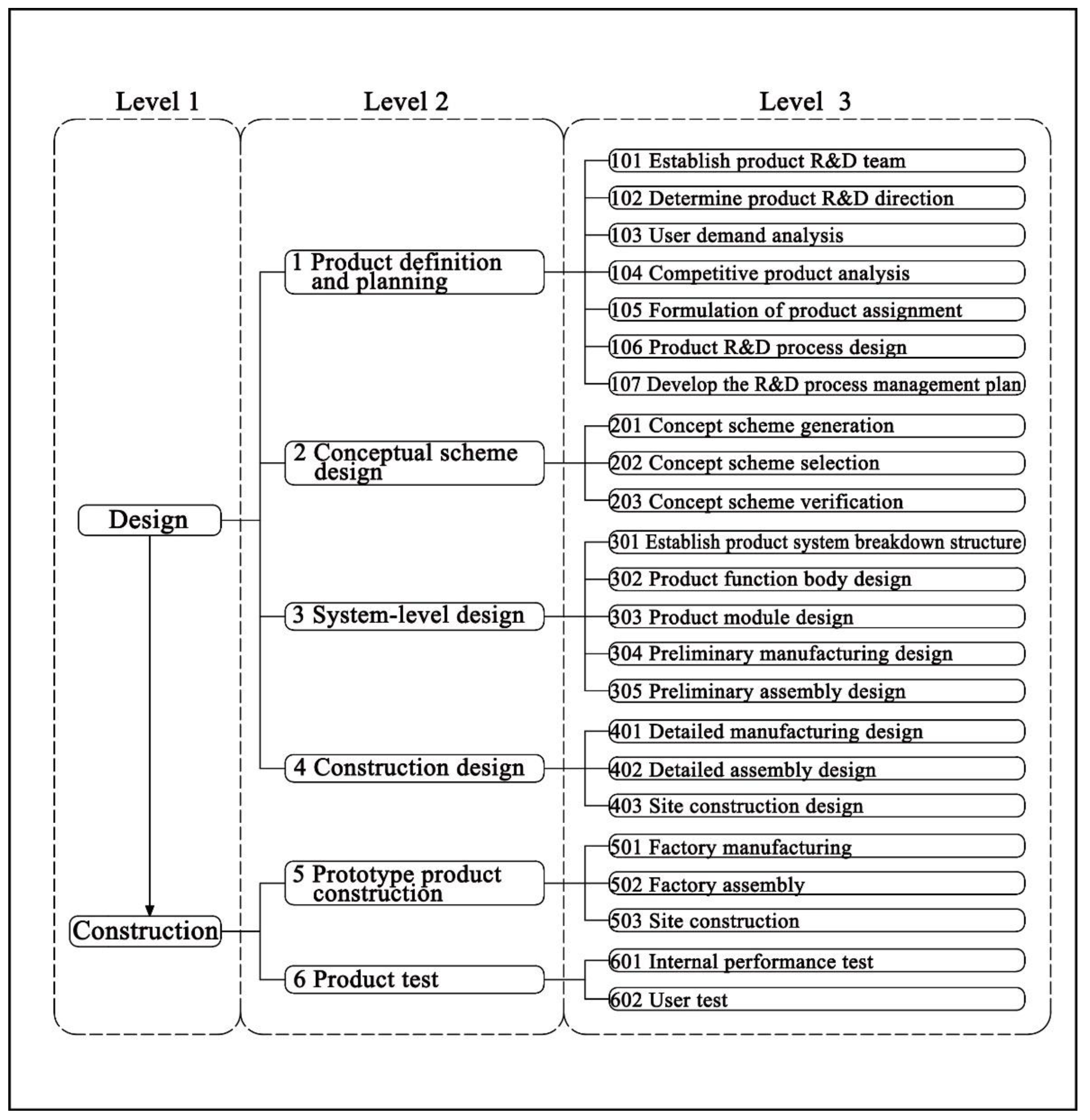


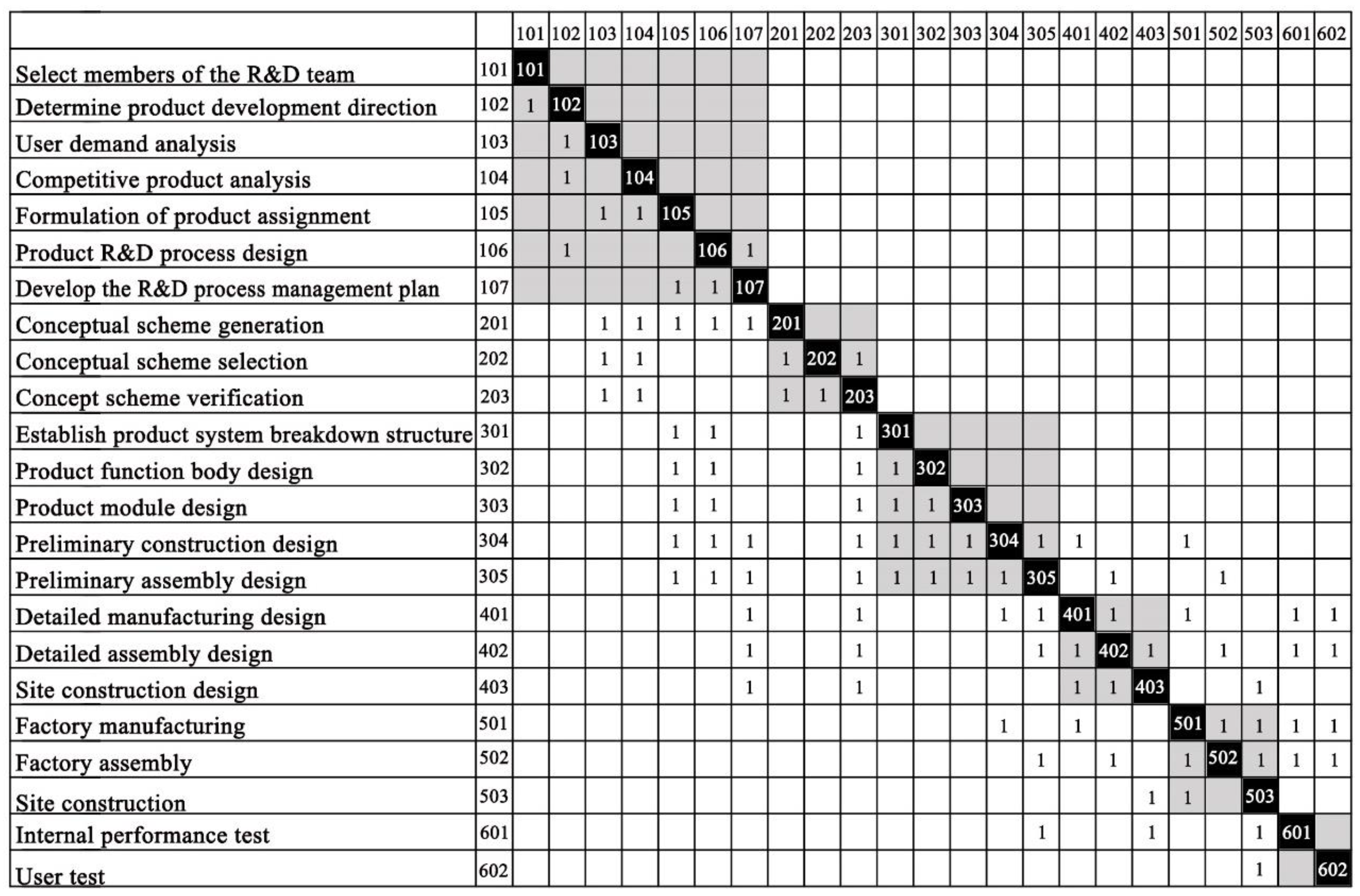

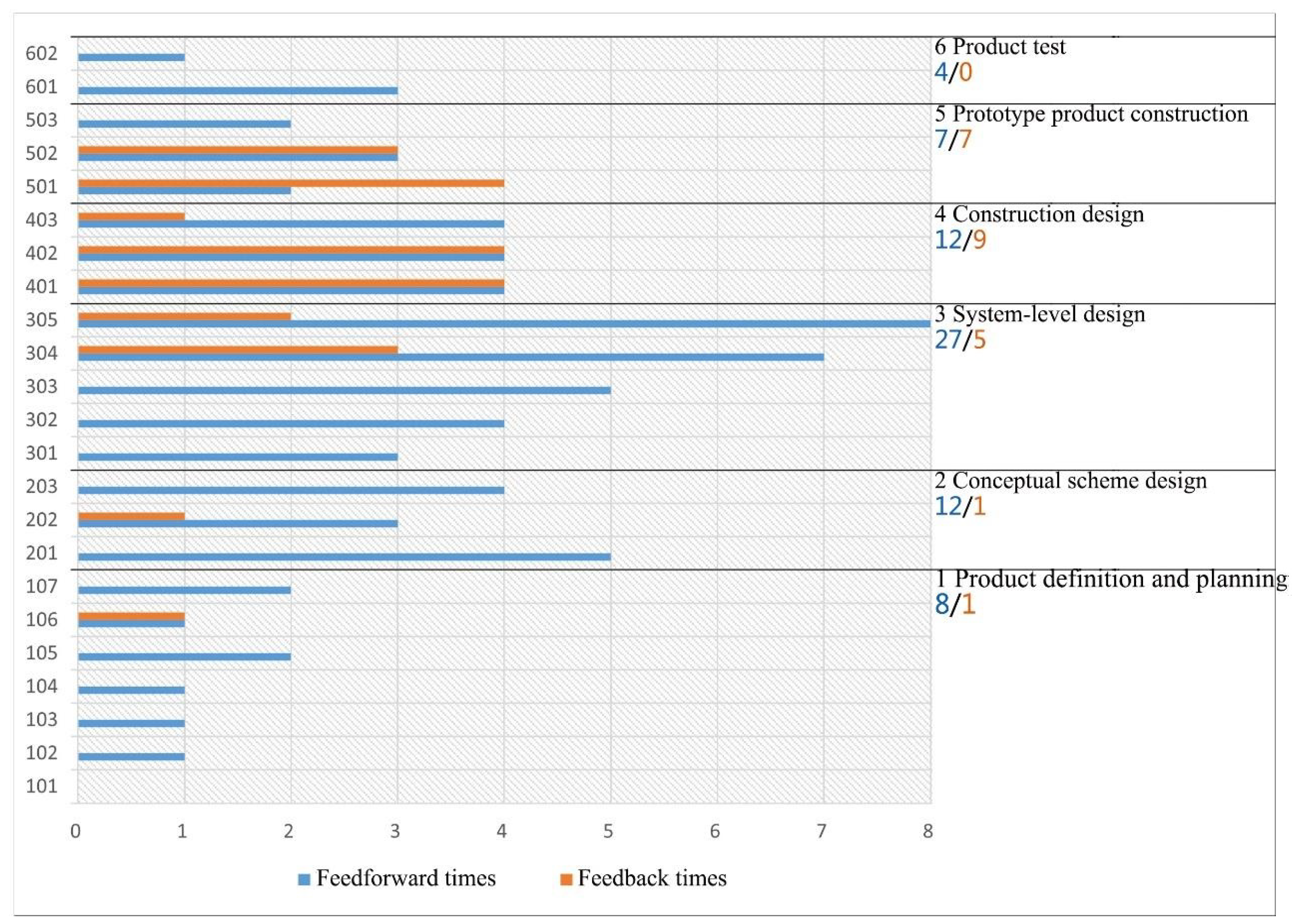
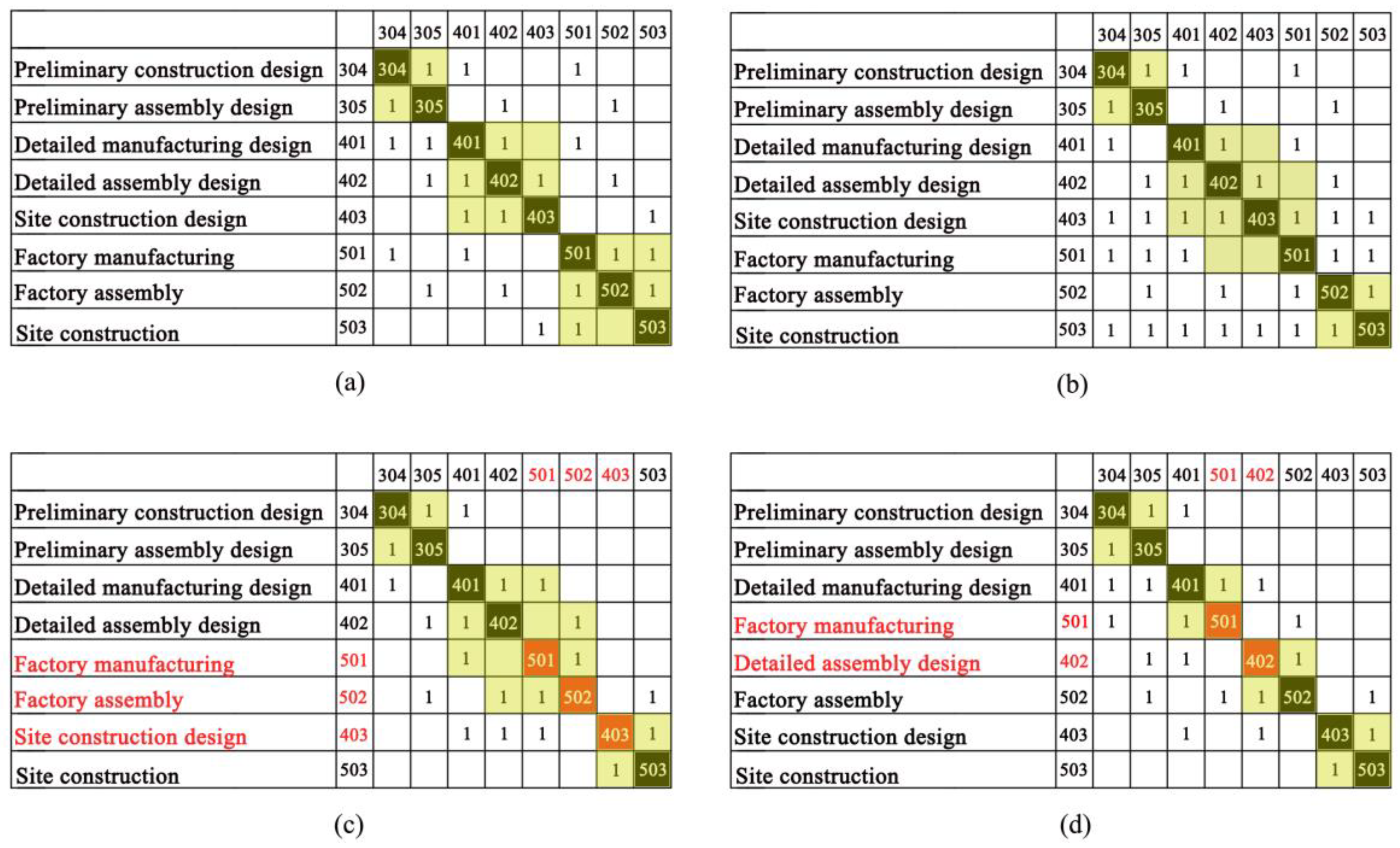

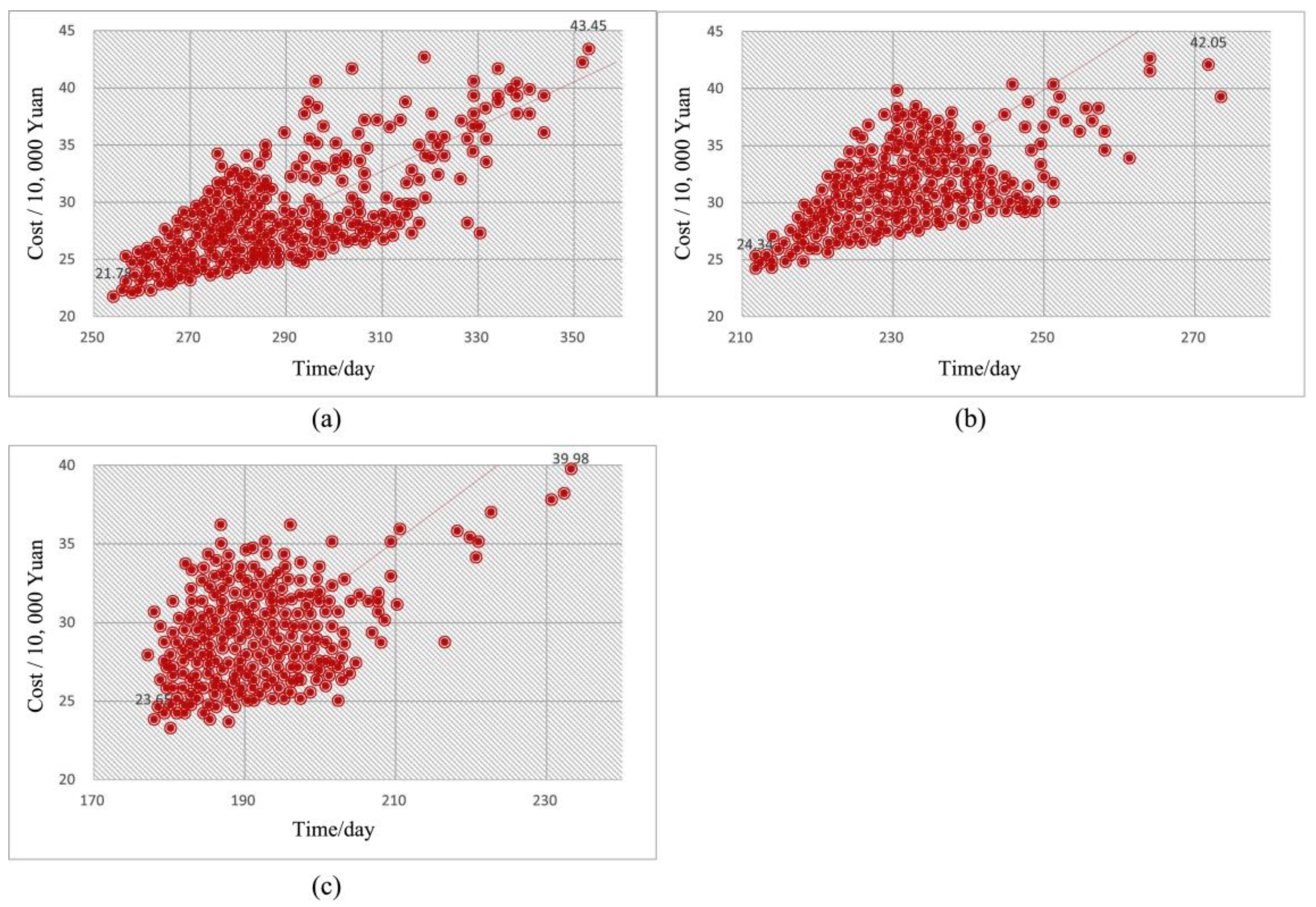
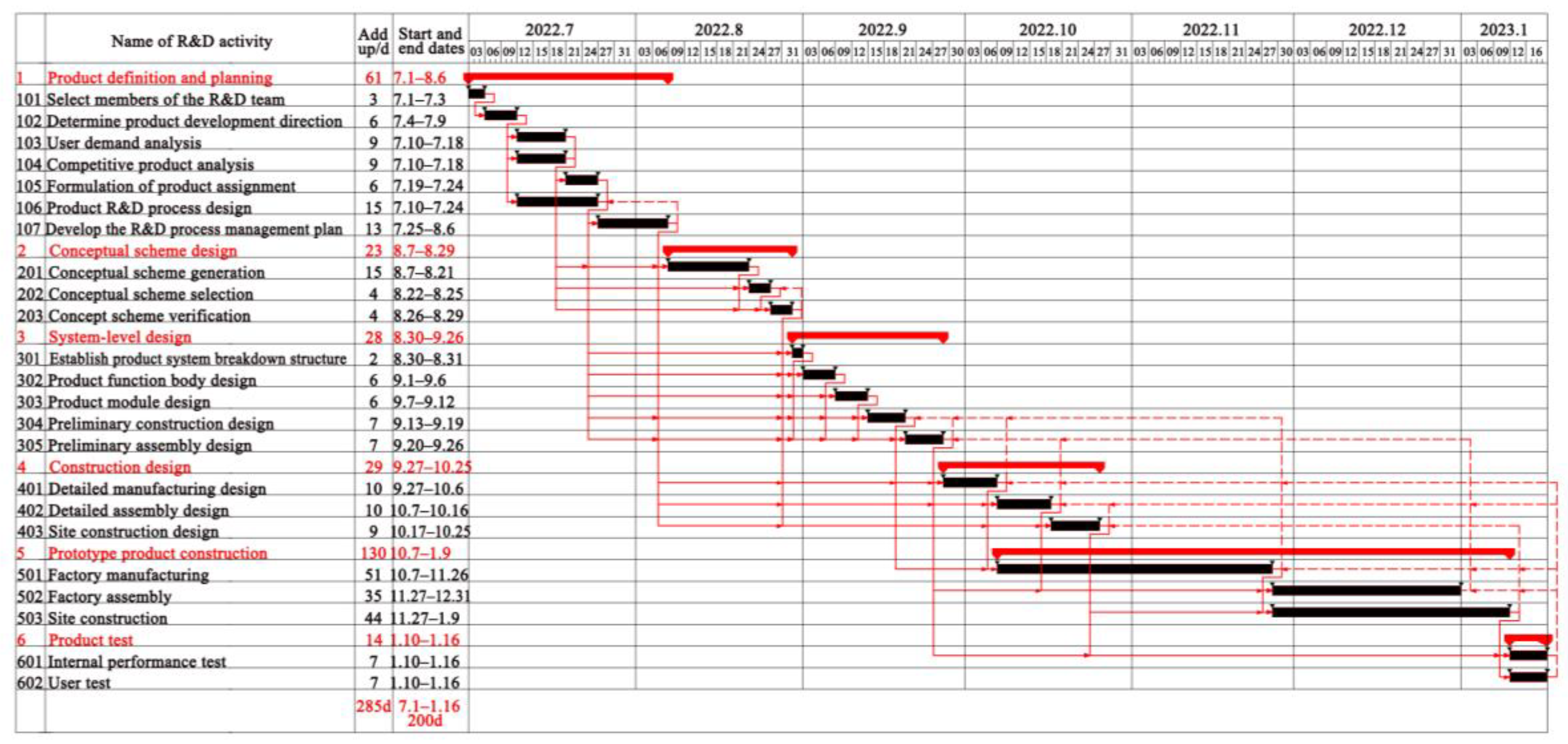

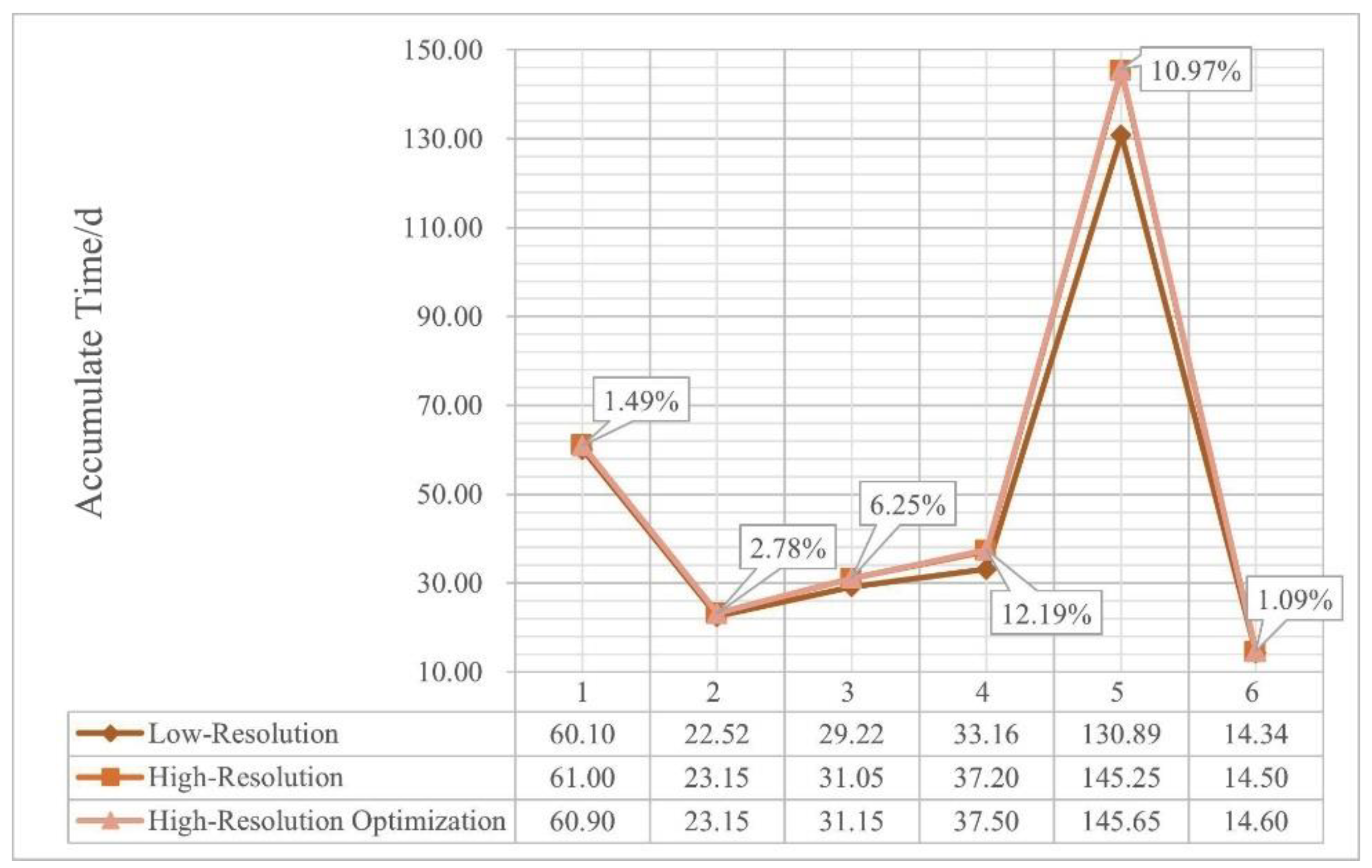
| R&D Activity Number | Name of R&D Activities | to/d | tm/d | tp/d | Cf/10,000 Yuan | Cm/ (10,000 Yuan•d−1) | Cv/ (10,000 Yuan•d−1) |
|---|---|---|---|---|---|---|---|
| 1 | Product definition and planning | 55.00 | 61.00 | 67.00 | 0.20 | 0.03 | 0.01 |
| 101 | Establish product R&D team | 1.50 | 3.00 | 4.50 | 0.02 | ||
| 102 | Determine product R&D direction | 5.00 | 6.00 | 7.00 | 0.03 | ||
| 103 | User demand analysis | 8.50 | 9.00 | 9.50 | 0.03 | ||
| 104 | Competitive product analysis | 8.50 | 9.00 | 9.50 | 0.03 | ||
| 105 | Formulation of product assignment | 5.00 | 6.00 | 7.00 | 0.03 | ||
| 106 | Product R&D process design | 14.50 | 15.00 | 15.50 | 0.03 | ||
| 107 | Develop the R&D process management plan | 12.00 | 13.00 | 14.00 | 0.03 | ||
| 2 | Conceptual scheme design | 20.00 | 23.00 | 28.00 | 0.20 | 0.03 | 0.01 |
| 201 | Concept scheme generation | 12.00 | 15.00 | 18.00 | 0.06 | ||
| 202 | Concept scheme selection | 4.00 | 4.00 | 5.00 | 0.07 | ||
| 203 | Concept scheme verification | 4.00 | 4.00 | 5.00 | 0.07 | ||
| 3 | System-level design | 20.00 | 28.00 | 34.00 | 0.20 | 0.03 | 0.01 |
| 301 | Establish product system breakdown structure | 1.50 | 2.00 | 3.00 | 0.04 | ||
| 302 | Product function body design | 4.00 | 6.00 | 8.00 | 0.04 | ||
| 303 | Product module design | 3.50 | 6.00 | 7.00 | 0.04 | ||
| 304 | Preliminary manufacturing design | 5.50 | 7.00 | 8.00 | 0.04 | ||
| 305 | Preliminary assembly design | 5.50 | 7.00 | 8.00 | 0.04 | ||
| 4 | Construction design | 25.00 | 29.00 | 35.00 | 0.20 | 0.05 | 0.02 |
| 401 | Detailed manufacturing design | 9.00 | 10.00 | 13.00 | 0.06 | ||
| 402 | Detailed assembly design | 9.00 | 10.00 | 12.00 | 0.07 | ||
| 403 | Site construction design | 7.00 | 9.00 | 10.00 | 0.07 | ||
| 5 | Prototype product construction | 100.00 | 130.00 | 170.00 | 10.00 | 0.05 | 0.02 |
| 501 | Factory manufacturing | 40.00 | 51.00 | 65.00 | 4.00 | ||
| 502 | Factory assembly | 25.00 | 35.00 | 50.00 | 3.00 | ||
| 503 | Site construction | 35.00 | 44.00 | 55.00 | 3.00 | ||
| 6 | Product test | 10.00 | 14.00 | 16.00 | 0.40 | 0.04 | 0.01 |
| 601 | Internal performance test | 5.00 | 7.00 | 8.00 | 0.20 | ||
| 602 | User test | 5.00 | 7.00 | 8.00 | 0.20 | ||
| total | 230.00 | 285.00 | 350.00 | 11.20 |
| Schedule | Mean Value | Standard Deviation | Min | Max | Average Cumulative Time |
|---|---|---|---|---|---|
| Low-resolution | 283.15 | 15.70 | 254.10 | 353.00 | 290.24 |
| High-resolution | 195.10 | 6.90 | 211.70 | 271.80 | 312.15 |
| High-resolution optimization | 165.20 | 5.80 | 177.90 | 233.20 | 312.95 |
| Cost | Mean Value | Standard Deviation | Min | Max |
|---|---|---|---|---|
| Low-resolution | 26.50 | 3.45 | 21.78 | 43.45 |
| High-resolution | 29.88 | 2.12 | 24.34 | 42.05 |
| High-resolution optimization | 28.90 | 2.80 | 23.65 | 39.98 |
| R&D Activities | Low-Resolution | High-Resolution | High-Resolution Optimization | ||||
|---|---|---|---|---|---|---|---|
| Accumulate Time/d | Accumulate Time/d | Growth Rate/% | Growth Value/d | Accumulate Time/d | Growth Rate/% | Growth Value/d | |
| 1 Product definition and planning | 60.10 | 61.00 | 1.49 | 0.90 | 60.90 | 1.32 | 0.80 |
| 2 Conceptual scheme design | 22.52 | 23.15 | 2.78 | 0.63 | 23.15 | 2.78 | 0.63 |
| 3 System-level design | 29.22 | 31.05 | 6.25 | 1.83 | 31.15 | 6.59 | 1.93 |
| 4 Construction design | 33.16 | 37.20 | 12.19 | 4.04 | 37.50 | 13.09 | 4.34 |
| 5 Prototype product construction | 130.89 | 145.25 | 10.97 | 14.36 | 145.65 | 11.28 | 14.76 |
| 6 Product test | 14.34 | 14.50 | 1.09 | 0.16 | 14.60 | 1.79 | 0.26 |
| Total | 290.24 | 312.15 | 7.55 | 21.91 | 312.95 | 7.82 | 22.71 |
| High-Resolution | High-Resolution Optimization | ||
|---|---|---|---|
| Parallel R&D Activities | Estimation of Time Reduction/d (tm) | Parallel R&D Activities | Estimation of Time Reduction/d (tm) |
| 104/103 | 9.00 | 104/103 | 9.00 |
| 106/103, 104, 105 | 9 + 6 = 15.00 | 106/103, 104, 105 | 19 + 6 = 15.00 |
| 501/402, 403 | 10 + 9 = 19.00 | 501/402 | 51.00 |
| 503/502 | 35.00 | 502/403 | 35.00 |
| 602/601 | 7.00 | 602/601 | 7.00 |
| Total | 85.00 | Total | 117.00 |
| Low-resolution average schedule time | 283.15 | Low-resolution average schedule time | 283.15 |
| Revised average schedule time | 198.15 | Revised average schedule time | 166.15 |
| High-resolution average schedule time | 195.10 | High-resolution optimization average schedule time | 165.20 |
| R&D Activity Number | Cm + Cv | High-Resolution | High-Resolution Optimization | ||
|---|---|---|---|---|---|
| Average Rework Time/d | Average Rework Cost/10,000 Yuan | Average Rework Time/d | Average Rework Cost/10,000 Yuan | ||
| 1 | 0.00 | 0.00 | 0.00 | 0.00 | 0.00 |
| 2 | 0.00 | 0.00 | 0.00 | 0.00 | 0.00 |
| 3 | 0.04 | 5.60 | 0.22 | 4.67 | 0.19 |
| 4 | 0.07 | 7.25 | 0.51 | 5.80 | 0.41 |
| 5 | 0.07 | 43.33 | 3.03 | 32.50 | 2.28 |
| 6 | 0.05 | 2.00 | 0.10 | 2.00 | 0.10 |
| 3.86 | 2.97 | ||||
| K• | 5.79~7.72 | 4.46~5.94 | |||
| + (K − 1) × | 28.43~30.36 | 27.98~29.47 | |||
Disclaimer/Publisher’s Note: The statements, opinions and data contained in all publications are solely those of the individual author(s) and contributor(s) and not of MDPI and/or the editor(s). MDPI and/or the editor(s) disclaim responsibility for any injury to people or property resulting from any ideas, methods, instructions or products referred to in the content. |
© 2023 by the authors. Licensee MDPI, Basel, Switzerland. This article is an open access article distributed under the terms and conditions of the Creative Commons Attribution (CC BY) license (https://creativecommons.org/licenses/by/4.0/).
Share and Cite
Wang, Y.; Bian, S.; Dong, L.; Li, H. Multiresolution Modeling of a Modular Building Design Process Based on Design Structure Matrix. Buildings 2023, 13, 2330. https://doi.org/10.3390/buildings13092330
Wang Y, Bian S, Dong L, Li H. Multiresolution Modeling of a Modular Building Design Process Based on Design Structure Matrix. Buildings. 2023; 13(9):2330. https://doi.org/10.3390/buildings13092330
Chicago/Turabian StyleWang, Yu, Suping Bian, Ling Dong, and Hongxian Li. 2023. "Multiresolution Modeling of a Modular Building Design Process Based on Design Structure Matrix" Buildings 13, no. 9: 2330. https://doi.org/10.3390/buildings13092330




